Sonic Strategies in the Library
Anne Evenhaugen : August 8, 2023 3:17 pm : Art and Design, Collection Highlights, Exhibitions, homepage, Intern and Volunteer Updates, Special CollectionsThis exhibition and blog post were curated and written by Joana Stillwell.
Sonic Strategies in the Library accompanies the newly opened exhibition Musical Thinking: New Video Art and Sonic Strategies at the Smithsonian American Art Museum. Musical Thinking, by Curator of Time-Based Media, Saisha Grayson, focuses on video art that uses sonic strategies including scores, improvisation, and interpretation, as well as styles, structures, and lyrics that speak to American life. The works selected for this accompanying exhibition at the American Art and Portrait Gallery Library (AA/PG) include books from the collection as well as materials from the artist files. Nine selections ranging from the early nineteenth century to the 2010s reveal the ongoing and evolving relationship between visual art and music and sound.
Music: A Mere and Colorful Memory
Before the advent of recorded sound, music was a medium only available to a live audience, and only recollected orally, or venerated in the visual arts. Painting was considered the main art in the early twentieth century and its ability to capture the essence of music was the focus of Luna May Ennis’ Music in Art (1904). This is embodied by the beautiful red and gold cover which centers a ribboned and stylized painter’s palette, while the border is compiled of different types of stringed instruments, pan flutes, and white flowers. The book is organized among themes of myth and enchantment, youth and love, worship and are punctuated by illustrations by Donatello, Raphael, Rubens, and more. The book reads as art historical analysis but through the perspective of a viewer trying to relive “the sound [that has died] with the vibration of the strings [and] with the breath of the singer becom[ing] a mere memory.”
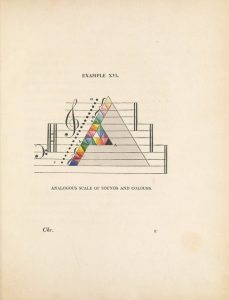
George Field’s Chromatics, or, an essay on the analogy and harmony of colours (1817) contains rich hand-colored wood-engravings with letterpress captions. Field was known as a chemist and for being especially skilled with pigments but fell short on being a color theorist after ignoring Isaac Newton’s ideas regarding color and light. Regardless, this book reveals his artistic sensibilities while expressing his theories on the relationship between the spectrum of colors and the scale of musical tones.
The Potentiality of Scores
By the twentieth century, music and sound recordings were readily available, which heightened the exceptionality and spectacle of the event or live performance. John Cage, a seminal influence on music, sound art, performance art, and more, was fascinated by the ability of music to make the listener more aware of their present. Cage argued any vibration of a particular moment could be considered music. While living in Europe as an art student he “noticed [on a street in Seville] the multiplicity of simultaneous visual and audible events all going together in one’s experience and producing enjoyment. It was the beginning of the theatre and circus.”
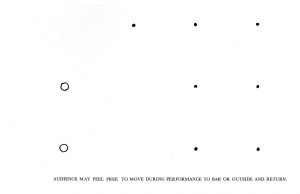
Variations IV (1965) is a work by Cage with composer David Tudor. It was presented at Cage’s first gallery concert, and is only remembered through printed instructions and a music sheet. The instructions read, “A performer need not confine himself to a performance of this piece. At any time he may do something else. And others, performing something else at the same time and place, may, when free to do so, enter into the performance of this.” Herbert Palmer, the owner of the gallery, recollected in a 2004 interview that Cage was in one room while Tudor was in another and between them were stacks of records and tapes.
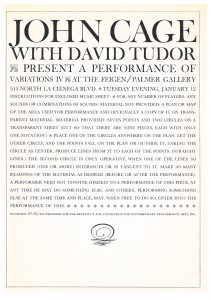
He remembered that each would turn on different recordings and the music would change depending on where you were in the space. Palmer expressed, “It was so wild, with all the different kinds of music going at once.” More of Herbert Palmer’s interview is available at the Smithsonian Archives of American Art.
Raven Chacon is an artist featured in Musical Thinking where a video work and original lithographs of four different scores are on display. The publication For Zitkála-Šá is a collection of this series of scores and the one selected in our exhibition is for his sister, Autumn Chacon. Similar to Cage’s musical sheet, there is a large location assumed or suggested. As a Diné and Xicana sound artist, activist, and community member, Autumn’s work examines contemporary methods of storytelling which dovetails into her work as a pirate radio engineer. In this score, Autumn is instructed to place, locate, and interact with lamps and radios while tracing her movements on the “score-map.” Every time the score is completed, a new path and story is forged and at the end she is invited to “sing the new song that [she] learned while performing the score.”
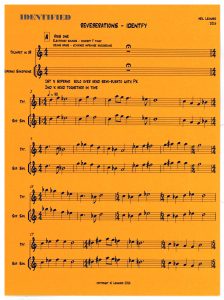
Soundscapes: Interpretations, Reverberations, and Process
In 2015, the Smithsonian National Portrait Gallery inaugurated its first performance art series, “Identify: Performance Art as Portraiture.” One of the performances, Identified by María Magdalena Campos Pons and Neil Leonard, was a study of President Abraham Lincoln, with the goal of reinserting the Black body into historical narratives evoking protest and devotion. The performance took place throughout the museum and its atrium. Portfolios containing 22 cards with texts, illustrations, and one musical score were handed to viewers. The score was performed by jazz musicians from Philadelphia, New Orleans, and Havana, a wind ensemble from the Duke Ellington School of the Arts, and folkloric musicians from Matanzas, Cuba. Together they reverberated the history that ties them together on the site of Lincoln’s second inaugural ball.
A promotional pamphlet for a monograph and two sound works, titled Finding Pictures in Search of Sounds (2008), depicts abstract fragments that question the interpretation of sound visually, aurally, and physically. The pamphlet by electronic musician and media artist, Stephen Vitiello, is a selection found in the AA/PG Library’s Art and Artist Files. The monograph contains individual booklets that act as visual clues to the sound pieces. Images of forests, reeds in water, and lines that mimic scores and wires can be vividly spread around a space without a distinct order and holds its own presence and experience. This pamphlet is just a shadow of the works it promotes, but reflects Vitiello’s practice of transforming unobserved atmospheric noises into engaging and imaginative soundscapes.

Womens Work (2019) is a facsimile of a publication from the mid-1970s. It was a magazine that highlighted the overlooked work of 25 female artists working with music, performance, and visual arts. Co-editor Annea Lockwood emphasized “We wanted to publish work which other people could pick up and do: that aspect of it was really important…this was not anecdotal, this was not archival material, it was live material. You look at a score, you do it.” One of the works in the book is by Lockwood herself and titled Piano Transplants (1968-1972). She cautioned that all pianos used for these performances should already be beyond repair, as she wrote and performed scores for the burning, drowning, and gardening of the instrument. She is particularly enamored with the environment, especially water, and collaborates and improvises with dancers, musicians, aquatic insects, and more.
George Brecht’s Water Yam (1963) was first published as a method to cheaply disseminate art democratically – widely and easily. Brecht was an important member of the experimental Fluxus art movement. The movement stressed the significance of the artistic process over the art product. The movement’s philosophy was grounded in experimental music and it was named after a magazine that featured artists and musicians who were influenced by John Cage. Water Yam is a box that contains many small, printed cards with instructions referred to as “event-scores.” Brecht became known for his haiku-like scores that left room for interpretation. Fourteen event-scores punctuate all three AA/PG Library display cases and were selected for their musical, performative, and tangential connections. These event-scores range from seemingly mundane tasks such as disassembling and assembling a flute, ambiguous encouragements of string quartets to shake hands, to supposedly more direct instructions to turn a radio on and then off at the first sound.
In the spirit of Musical Thinking, the library selections highlight visual works where music and sound – its memory, creation, and lived experience – is the primary focus. It also reveals how the visual arts has and continues to praise, document, and provide new pathways and interpretations of the fleeting medium. A particular event-score by Brecht feels like a fitting selection with which to conclude:
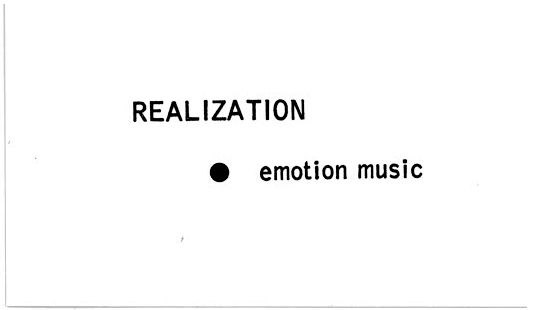
This exhibition and blog post were curated and written by Joana Stillwell, the Audiovisual Archivist at the Mid-Atlantic Regional Moving Image Archive (MARMIA), who was the 2022 ARLIS/NA Wolfgang M. Freitag Internship Award recipient and was hosted at the Smithsonian American Art and Portrait Gallery Library. The exhibition will be on view from July-October, 2023, in the AA/PG Library.
A Christmas Carol Imagined by Arion Press and Ida Applebroog
Alexandra Reigle : December 22, 2022 9:00 am : Art and Design, Collection Highlights, homepage, Special Collections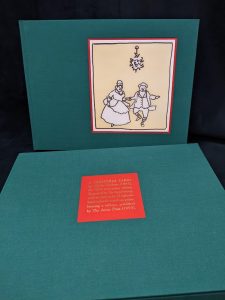
It is nearly impossible to go through a holiday season and not view some rendition of Charles Dickens’ A Christmas Carol, whether it be in writing, on the stage, or on your television. There have been countless interpretations, each with their own altercations. However, the core message of generosity, empathy, and repentance often remains the same, no matter the method A Christmas Carol is produced.
…
It’s Alive! Arion Press’ Frankenstein; or, the Modern Prometheus
Anne Evenhaugen : October 31, 2022 9:00 am : Art and Design, Collection Highlights, Holidays and Special Occasions, homepage, Intern and Volunteer Updates, New and Notable, Special Collections“It’s alive!” During the spooky season celebrated around Halloween, decorations and costumes of classic pop culture creatures abound, like Dracula, the Wolfman, and Frankenstein’s monster himself. Our modern conception of Frankenstein is a loveable zombie, tall and dopey with green skin and spiky hair, bolts and stitches. Originally published in 1818, Frankenstein, or The Modern Prometheus actually tells the story of Dr. Victor Frankenstein and his ill-fated desire to create the “perfect being.” The author, Mary Shelley, explored the consequences of playing God, the corrupting influence of misdirected ambition, the possibilities and limitations of science. Frankenstein’s “Creature” has fascinated readers for over 200 years, and Shelley’s work has been published countless times since her lifetime.

The Smithsonian’s American Art and Portrait Gallery Library has recently acquired the 2019 rendition of Frankenstein; or, the Modern Prometheus, published by Arion Press in honor of the original book’s 200th anniversary.
Arion Press specializes in handcrafted fine press books and is known for their collaborations with artists and authors. For Frankenstein, Arion teamed up with American sculptor Tim Hawkinson, working in the book form for the first time. The artist often uses common household or found materials in his inventive sculptural objects and kinetic machines. For this publication, Hawkinson devised a unique technique to create the accompanying images. Affixing a hypodermic needle to a fountain pen and creating a built-in inkwell that consisted of a soda bottle filled with ink, Hawkinson suspended the entire contraption from the ceiling of his studio. The large paper was pinned to a turntable on the wall, and each horizontal mark with the delicate tip of the needle and the turning of the paper on the turntable caused the ink to dribble in unexpected ways. Not only is this artistic technique unique, but this system was just unwieldy enough to seemingly have a mind if its own, an autonomous creation that evokes the novel. The hypodermic needle echoes how Dr. Frankenstein used syringes to bring his creation to life, and how they defied his expectations. The hundreds of straight and sketchy lines come together to create an eye-catching spooky, dreamy vibe that compliments the story.
The Smithsonian holds the deluxe edition of Frankenstein; or, the Modern Prometheus, presented in a wooden box carved in Hawkinson’s same sketchy lines with the image of a ship’s mast and rigging. Each chapter in the book has one of the nine prints created for this volume, giving the reader an image that compliments the narrative as it unfolds.

Interestingly, Hawkinson’s drawings never show the Creature itself, furthering the interpretation that the Creature was perhaps not the true monster, and that it was Dr. Frankenstein himself whose ambition ignored the rules of nature, pushing the scientific boundaries until his own creation destroyed him. There is no correct answer, leaving the reader to speculate and draw their own conclusions.

You can read more about Mary Shelley’s Frankenstein and how she was inspired by the history of 19th-century chemistry and electricity in the Body Electric in the Smithsonian Libraries online exhibition for Fantastic Worlds: Science and Fiction, 1780-1910. In addition, you can read more about Arion Press’ Frankenstein and their production process in their full prospectus on the Arion Press website. Other resources consulted include The Many Editions of Frankenstein, a blogpost from the University of North Georgia Press, October 26, 2018, and Pace Gallery’s information on artist Tim Hawkinson (both accessed 10/28/2022.)
This blogpost was co-written by Amanda Fiske, an intern through SAAM’s Advanced Level Program, and working with the AA/PG Library for the full academic year. She is currently a student in the Master’s in Library and Information Science program at the University of South Florida.
Turning a Quarantine Into a Journey With Xavier de Maistre
Anne Evenhaugen : March 22, 2022 9:00 am : Art and Design, Collection Highlights, homepage, New and Notable, Special Collections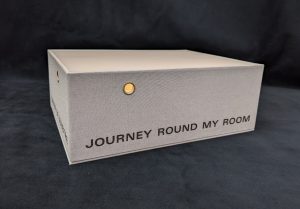
In a love letter to his apartment, Xavier de Maistre writes of his walls, windows, and furniture in Journey Round My Room, as if he would rather be there than anywhere else in the world. Joyful descriptions of the objects and activities in his room, such as the “quiet pleasure conveyed to his soul” during the act of dusting a painting, or the ruminations on his bed and its “agreeable colors” (rose and white) that add “not a little to the pleasure” of lying in it. As he alights his focus on particular objects, he recounts stories and memories they evoke, such as an entire chapter dedicated to just his traveling coat, “made of the warmest and softest stuff I could meet with. It envelops me entirely from head to foot, and when I am in my arm-chair, with my hands in my pockets, I am very like the statue of Vishnu one sees in the pagodas of India.”

De Maistre’s work is nearly 200 pages of such contented observations of his small space. As the world has spent more than two years enmeshed in the COVID-19 pandemic in periods of isolation in our homes, Journey Round My Room may feel like a familiar experience in 2022. However, this work was written in 1790, during the time of the French Revolution, by a soldier sentenced to house arrest for 42 days, a literal quarantine.
A young soldier, de Maistre engaged in an illegal duel, and as punishment, was placed under house arrest in Turin, seeing only the servant who brought his meals (and dressed him and made his bed—quite decadent.) It was during this confinement to just his own room that de Maistre wrote this love letter to his surroundings. Likely an attempt to thwart boredom and unhappiness at his situation, his writings were a whimsical travel diary of his close quarters, published by his brother in 1794 as Voyage Autour de ma Chambre.
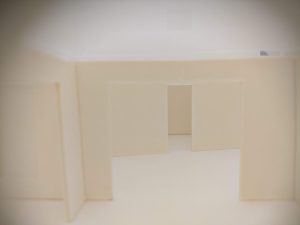
The Smithsonian Libraries and Archives has a beautiful copy of the 2007 Arion Press edition of Journey Round My Room, as a part of the recent gift to the American Art and Portrait Gallery Library from collector Dr. Ronnyjane Goldsmith. The book is bound in pink and white cloth, a nod to the “agreeable” rose-colored surroundings of de Maistre himself. Ross Anderson contributed more than a dozen ghostly photographs of a generic room, using a low-resolution cell phone, and printed in gray tones on translucent paper.
Of particular note for the Smithsonian’s copy is the limited special edition’s housing—a 3-dimensional apartment for the viewer to “journey” through, via portholes along the sides. Similar to a shadowbox, inside is a small white model, and each peephole allows a restricted viewing of the tiniest doors, windows, and walls of de Maistre’s imagined rooms. The cover forms the “ceiling”, made of translucent plexiglass that allows diffused light to make interesting shadows on the halls and doorways. Only 30 of the edition with this special box were created, designed by Anderson, himself an architect. The work adds to the Smithsonian’s collection of American fine press publications and is an amazing example of creativity in bookbinding.
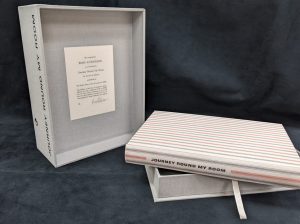
De Maistre’s reflections during a period of solitude provide a timely addition to our own, a strangely prescient reminder to take joy in simple observations, and that there are many ways to travel, not the least of which is through one’s imagination.
Significant Collection of Arion Press Publications Comes to Smithsonian Libraries and Archives
Anne Evenhaugen : January 31, 2022 9:00 am : Art and Design, Collection Highlights, homepage, New and Notable, Special Collections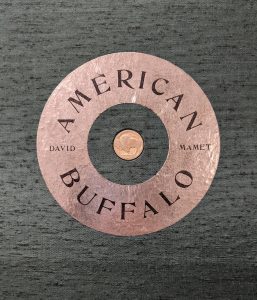
The Smithsonian Libraries and Archives is pleased to announce a significant acquisition of fine press books published by the Arion Press in San Francisco. Thanks to a gift from Dr. Ronnyjane Goldsmith, over a hundred titles will soon be added to the American Art and Portrait Gallery Library.
Arion Press was founded in 1974, but tends much older roots of the former type foundries and presses it has grown from, such as the Grabhorn Press and Mackenzie & Harris. Since its inception, Arion has become one of the most sought-after and noteworthy presses in the United States.
Arion’s publications are handcrafted with fine paper, with hand-cast and handset type, each book individually bound and sewn. With this attention to detail and fine materials, each book is published in editions of only a few hundred copies, many with even smaller deluxe runs.

A uniquely interesting aspect of Arion’s work is the collaboration with fine artists, particularly international and American artists who are not generally known for book illustration. Each book is planned and crafted with the artist making a significant contribution to the final design and production, often resulting in interesting uses of materials, bindings and housing, and wholly new illustrations. These artists include Bruce Conner, Richard Diebenkorn, Julie Mehretu, Martin Puryear, Laurie Simmons, Kiki Smith, Wayne Thiebaud, and Kara Walker—many artists whose works are collected at the Smithsonian’s art museums.
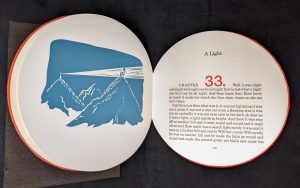
Arion’s collaborations develop in myriad ways, with the publisher seeking artists and recommending texts, or authors writing new works to engage with a particular artist, or the artists themselves bringing ideas of inspiring texts to illustrate. Many of the artists who have worked with Arion have expressed their joy in the partnership. American artist Jim Dine noted “My association with…Arion Press is so great I want it to go on as long as I live.”[1] Dine has had his work incorporated in at least nine Arion publications, five of which are now in the collection of the Smithsonian Libraries and Archives.

The collection was donated in 2021 by author and entrepreneur Dr. Ronnyjane Goldsmith. Goldsmith began collecting Arion Press publications more than 20 years prior, when she first encountered the Constitution of the United States of America, Arion’s 1987 collaboration with the Library of Congress in celebration of the U.S. Bicentennial. She ultimately bought three copies of Arion’s Constitution, and became a subscriber to the Press, receiving every book they produced during the period. Over time, she sought out previously published works from dealers to complete her collection, with just two dozen left to collect at the time of donation. Dr. Goldsmith has also sponsored a subscription for the Smithsonian Libraries and Archives to continue to receive Arion Press’ new publications in their series. As a collector, Dr. Goldsmith has kept the books in immaculate condition, each with original wrappings, letters, and prospectuses.
Dr. Goldsmith’s gift to the Smithsonian Libraries and Archives includes 103 unique titles from Arion’s official titles in their catalogue, in addition to examples of a title in multiple edition types, such as variant or deluxe, or with associated suites of prints.
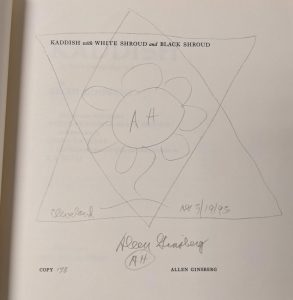
The gift of such a significant number of Arion publications adds depth and dimension to the Smithsonian’s already robust collection of American fine print and art history. With the gift, the Smithsonian Libraries and Archives has one of the most complete public collections of Arion’s work in the Washington D.C. area.
[1] “Marrying the Elements of a Handmade Volume Becomes a Fine Art.” 1984. New York Times, Oct 28, 5.
Banner image of printed cotton colorful flags: cover of Porgy and Bess, Arion Press, 2013.

Be First to Comment